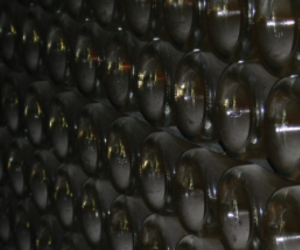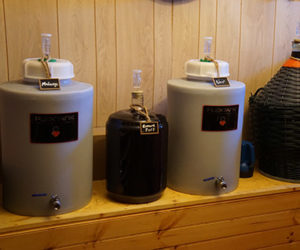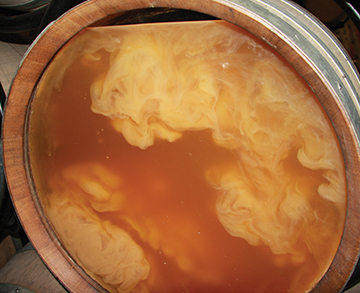
There’s a lot one can do with lees! Lees can add aromatic complexity, soften tannins, enrich mouthfeel, protect your wine from oxygen, feed malolactic bacteria, and add long-term stability. They’re prized, especially in sparkling wines, to add bready, yeasty, nutty aromas, and in wines around the world to add weight and richness. There are lots of ways and points in time during the winemaking process that lees can be utilized. They don’t come without their risks, but these are minimal, especially if managed properly. Aside from what they can do, they’re a lot of fun to work with, and are a unique “additive” to winemaking, in that they actually come from the wine itself!
Life cycle of Lees
Lees are dead yeast (and to a lesser extent bacteria) cells. Yeast cells ferment your wine, die at some point, and eventually settle to the bottom of your wine vessel as fermentation slows. Once a wine has fermented, what settles out of it is known as the gross lees, and includes these dead cells, as well as grape bits, bugs, dirt from grape surfaces, tartrate crystals, and whatever other solids made it into the fermentation. As we’ll discuss, gross lees can be refined into fine lees, which are mostly just the dead cell bodies. Wines aged “sur lie” or “on the lees” typically refer to wines aged on just the fine lees, however some adventurous winemakers choose to age on the gross lees.
Inside of the dead yeast cells are compounds called mannoproteins. These mannoproteins are what add aroma, add mouthfeel, coat tannins, and provide other benefits. However, it takes time for the lees to release the mannoproteins. Lees do very little in their first six months or so in a wine to directly affect wine character. In this early period, they scavenge oxygen and can be a food source for malolactic (ML) bacteria. Their oxygen scavenging can be helpful in whites, rosés, and lighter reds, warding off and delaying oxidation, though may not be ideal in this early period for structured, tannic reds (more on this later in “Lees and Red Wines”).
Things start to get more interesting at the six-month point, when the membrane of the dead yeast cells — forgive my graphic imagery here — begins to decay in your wine, slowly and increasingly releasing their guts (mannoproteins) into the wine until they rupture, spilling more mannoproteins into the wine. This rupture, known as autolysis, begins at around a year, though can be sped up some through bâttonage (lees stirring) and warmer temperatures. The longer the wine is aged on the lees, the more of an impact the lees will have on that wine’s character.
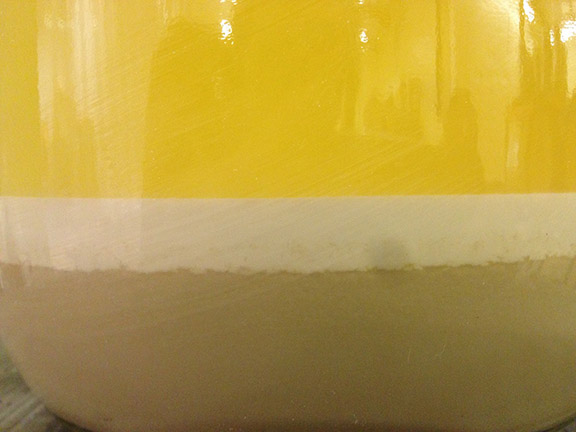
Do I Want to Use Lees?
Before getting into all things lees, make sure they’re something you want influencing your wine. Do their effects fit with your stylistic goals? I worked with them for many years, as they’re so interesting, but realized that while I wanted the potential for increased longevity and stability they offer wines, they often didn’t make sense for what I wanted stylistically, which is leaner, lighter wines. If you are looking to make fuller, rounder wines, they probably make sense to use. There are other stylistic factors to consider, of course (their effect on diacetyl levels, for example), as well as practical ones (lees as nutrients for malolactic bacteria).
Keeping Lees Happy
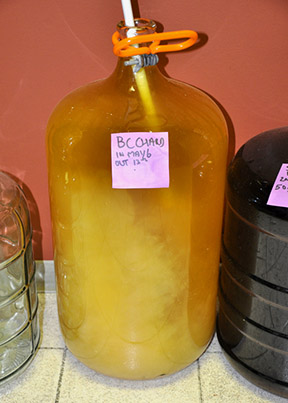
Like oxygen, if not tended to, especially early on, lees are prone to cause reduction (hydrogen sulfide production). Healthy lees smell great, yeasty, bready, floral, or fruity (I had lees once that smelled just like fresh mango). Bâttonage is not inherently necessary, but it’s a good idea, especially for the first few months of aging. Bâttonage suspends the lees into the wine, giving them access to some oxygen (which the bâttonage itself introduces), and doesn’t allow them to compress under their own weight, which encourages reduction, and is the primary risk in lees aging.
A safe regimen would be bâttonage every couple weeks for the first few months of aging. If aging in barrels, kill two birds with one stone: Doing bâttonage before topping can save you the need to remove a little wine to make space for the lees stirrer, and minimizes how many times you open the barrels. Every couple weeks is usually enough to keep lees from reducing, and also coincides with malolactic fermentation, if you’re carrying it out. More frequent (and vigorous) bâttonage encourages earlier autolysis, and thus speeds up access to the direct effects of lees mentioned earlier.
Bâttonage (baton is the French word for stick, which was traditionally used) is usually done today with a stainless steel rod with an oblong, loose flipper attached to one end. Some winemakers use golfing putters, which I’ve heard are gentler on the inside of barrels. However, anything long enough to reach the bottom of your vessel, rigid enough to stir with, and that has the ability to be sanitized will work; for carboys, I’ve used the hard plastic racking wand. The goal is simply suspending the lees: Just insert the instrument of your choice into the vessel and stir long enough to suspend the lees — it’s easiest in carboys as you can see when they reach the top.
A trick with carboys: You can gently angle the carboy to one side and roll it circularly on its base to whisk lees into suspension, thereby avoiding opening the carboy to stir, introducing oxygen and dealing with sanitization, etc. It’s not as effective as stirring, but saves a lot of hassle. Be extremely careful if doing this — carboys are delicate, their glass thick, and breaking one can lead to serious injury. If a carboy falls or breaks, do not try to catch or save it. This is best done slowly and gently on a soft surface, like carpet or mat.
Separating the Fine from the Gross lees
As mentioned, some winemakers do like to age on the gross lees, and this can lead to interesting, reductive, funky aromas, but it also ups the risk of winding up with too much reduction or introducing spoilage bacteria that may be on grape bits and lees themselves. Thankfully, separating the gross from the fine lees is simple. After fermentation has stopped and the lees have settled, stir everything vigorously to suspend them in the wine. Wait 24 hours for the heavier stuff (gross lees) to settle to the bottom of your vessel, then rack. The fine lees take days to settle, so the cloudy, leesy wine you rack will contain just the fine lees.
If you want to get rid of your fine lees too, either right after fermentation, or at any point during aging, simply let them settle for five or so days after fermentation has stopped or your last stirring and rack the clear wine off of them. If your wine is clear (i.e. not opaque from being full of suspended lees — obviously easier to gauge with whites), you’ll carry over little or none of what is in the originating vessel. It’s best to move vessels as little as possible prior to this racking, as movement disturbs and suspends lees. For reds after pressing where I don’t want to use lees, I usually let the wine settle for two days before racking to barrel, and months later when I rack I usually have very little in the way of lees.
Lees and ML
Lees do cool things when it comes to malolactic fermentation; they can provide nutrients for the malolactic bacteria to feed on, which is especially helpful if you choose not to use commercial nutrients. Another benefit is lees scavenge oxygen and ML bacteria also prefer reductive environments. As mentioned, early bâttonage is good to keep the lees from reducing, but it also suspends them, allowing them to disperse these nutrients and scavenge oxygen in the full mass of wine, not just at the bottom of the vessel. Bâttonage does introduce some oxygen, so it may be a bit of a wash at the end of the day, but, especially so early in a wine’s life, some oxygen isn’t going to do any damage.
Lees and Diacetyl
The increased mouthfeel from lees aging might be desirable to winemakers who are also interested in diacetyl’s buttery character, commonly sought in certain styles of Chardonnay. However, the buttery characteristic is actually diminished by lees aging (and many of the world’s most revered Chardonnays are left on the lees for extended periods until it is time to bottle). Diacetyl is produced from ML bacteria as a byproduct of their activity. Different ML strains produce different amounts. Lees aging diminishes what’s produced. If you want to age on the lees and want that buttery character, choose a high diacetyl producing strain like EnartisML MCW or Scott Lab’s Beta and PN4, and hope you don’t lose too much during lees aging. Also, inoculate for ML after alcoholic fermentation is over, as active yeast eat diacetyl. Conversely, one way of lowering diacetyl levels is to age on the lees, as well as inoculating for ML a couple days into alcoholic fermentation with a low diacetyl producer, like VP41 or O-Mega.
Lees and Stability
Lees aging discourages protein colloids (protein haze) from forming when a wine is exposed to heat. It also discourages tartrate crystals from forming. This adds a degree of protection against these happening, especially if you choose to skip fining or cold stabilizing. This doesn’t mean that lees aging nullifies the need to do these if you want to ensure a clear, tartrate crystal-free wine, but
helps some.
It’s somewhat theoretical, but lees aging is associated with wine longevity. The thought is that compounds from the lees in a wine, over the years in bottle, sacrificially oxidize in place of the wine itself. This may lead to the wine having a longer life, during which it can evolve more than it may have without lees aging.
Lees and Red Wines
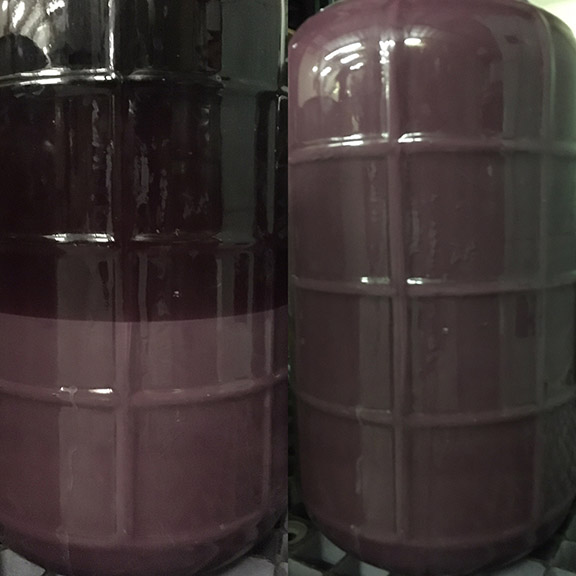
Although usually associated with white wines, lees can be beneficial in red wine production too. They can increase mouthfeel as well as coat and soften harsh tannins. However, timing is critical! Early in a red wine’s life — especially a structured red wine (high tannins and color) — lees can cause problems in two ways. They consume oxygen, which suppresses color/tannin polymerization, and thus may lead to less than ideal polymers. Lees also adsorb monomeric (unbound) color, creating a smaller pool of anthocyanins to bond with tannins. Both of these factors can lead to longer tannin/color polymers, which (though contrary to common lore) increase astringency, make wines less soft, and may shorten the life of your red wine.
So, how do you avoid these drawbacks and still reap the benefits? Simply remove the lees after fermentation and put them back once most of your polymerization has completed. Once color has bound with tannin, it is safe, and the lees can’t adsorb them any longer. Rack your wine off the fine lees (as described earlier), but instead of throwing the lees out, scoop them in a carboy and top with wine to fill the container. Lees, because they eat so much oxygen, are very stable (more so than wine), so storing them is no problem — just be sure to stir them every week or so to avoid compacting/reducing. If they do reduce and get stinky, don’t use them.1 The carboy tilted rolling trick won’t work here, as lees are so thick that removing the bung and stirring will be necessary.
How do you know when it’s time to put them back in? A safe bet is to add them back after about six months, but you can play it safe by testing to see if your color has polymerized/stabilized. Little monomeric color is visible at wine pH (for example, 25% is visible at 3.7 pH), however by lowering the pH we can see it all. Take two small samples of your wine in clear glasses, add 10% sulfuric acid into one of the samples (i.e., if you have a 50 mL sample, add 5 mL of sulfuric acid). Compare the rim (meniscus) of the two samples for color density. Soon after fermentation, the acidified sample should show more color density. Try this again at six months, if most color has polymerized, there will be a negligible difference between the two samples. Note: The acidified sample will change hue, getting brighter or pinker, ignore this, as we are only concerned with color density for this test.
Once you add the lees back in you can do bâttonage from time-to-time to help them integrate into the wine. In fact, in Postmodern Winemaking, Clark Smith states: “In big wines, this process may actually allow the wine to take up the entire mass of fine lees after two or three years in barrel.” Smith also cautions that it’s important that lees “be matched to the wine involved, as Cabernet lees will ruin a Pinot, while Pinot lees will deplete a Cab.”
Lees from Last Year
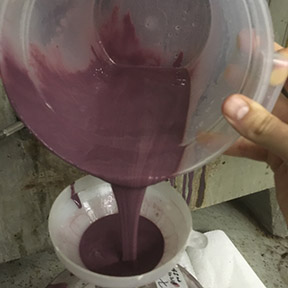
After you rack off the lees to bottle, you don’t have to throw away your beloved lees! You can keep them for use in your following vintage. Lees can be stored as described earlier and then added to the following vintage after fermentation. The previous vintage’s lees will already be in the process of autolyzing, so this is a shortcut to lees character allowing you to skip waiting for the new vintage’s lees to autolyze. This way you can bottle earlier if you want, with lees character — you can have your lees and drink them too! Similarly, but in the opposite direction, if aging older vintages that are “drying out . . . lees from the current vintage can prove useful for freshening and softening older wines on the verge of collapse.”1
When to Skip the Lees
You can see there are a lot of reasons and ways to use lees, but when might you want to skip or get rid of them? They may simply not fit your stylistic goals. If you want a lighter, leaner white wine, you’d want to remove them by around six months, which is when they will start to leak mannoproteins and begin to fatten up the wine. Before that, you may want them around to help scavenge oxygen and maintain a reductive environment, especially if working with low SO2, or to feed ML bugs.
Microbes can latch onto lees cells — including spoilage microbes — so, especially if fermenting spontaneously and/or working with low SO2, where you likely have a larger population of more diverse microbes, keeping the lees adds an additional risk factor. Thousands of wineries do this with no problem, but it does add a degree of risk. So, if fermenting spontaneously and/or working with low SO2, this is one more reason to taste regularly and, if you want to be extra safe, monitor bacterial populations with a microscope from time-to-time to catch lactic acid bacteria problems as early as possible.
If you are aging your wine on the lees and it starts to taste overtly or increasingly reductive (like hydrogen sulfide, stinky, metallic, oniony, or fecal) you want to rack off the lees and get rid of them. The racking should dissipate some, or all, of the reductive aromas (unless they’re turned into dimercaptans) and if the lees were the problem, removing them avoids increasing reductive character.
Lees are an extremely versatile tool in a winemaker’s toolbox; in fact, I’m hard pressed to think of anything else in the winery that can serve so many purposes. Depending on your stylistic goals, the benefits of use may be many, and the risks quite low. Whether inspired by Champagne or Muscadet, round, soft reds, or by the more theoretical longevity-related aspects, lees can help you achieve many goals.
References:
1 Smith, Clark. Postmodern Winemaking. 2014. University of California Press, Berkeley and Los Angeles, California.


